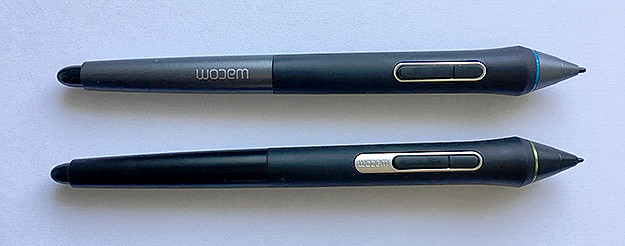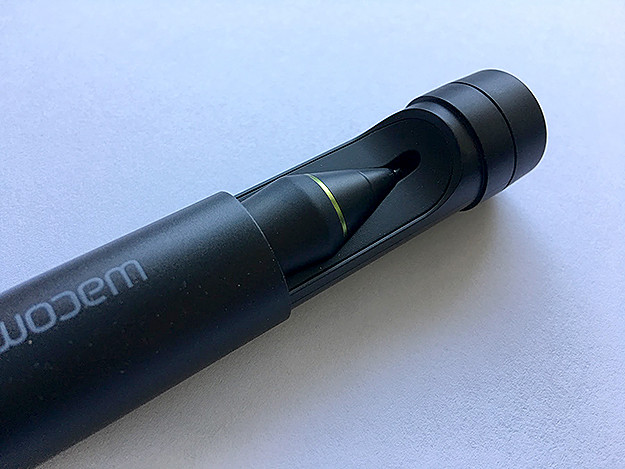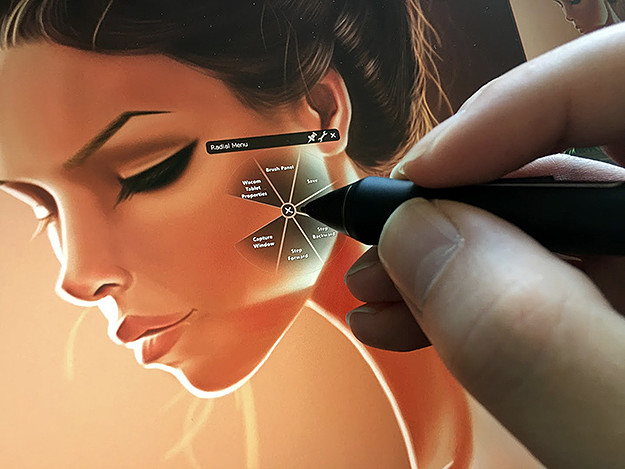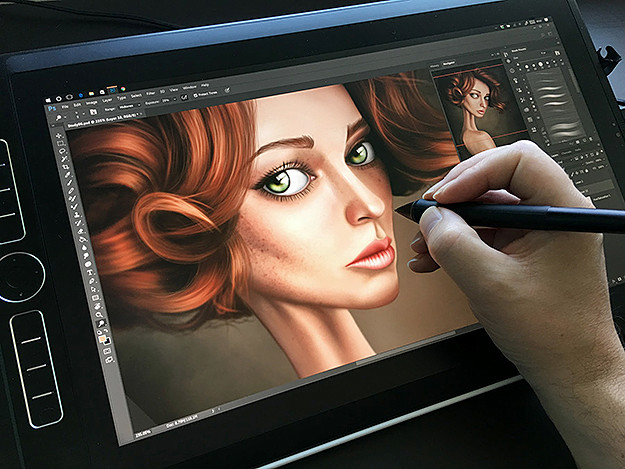
MobileStudio Pro 16 Review
It’s no secret that Wacom’s foray into the mobile market has been a patchy one. Throughout the Cintiq Companions four-year lifespan we have seen many iterations, including an Android based system, as they test the market and tweak the design to hit that sweet spot of functionality and mobility.
Unfortunately, although good devices, they have been marred by issues of weight, battery life and noise. Not to mention a clumsy stand and hefty price tag, which put many in a difficult decision when deciding where to spend their hard-earned money.
This year, we not only saw a new selection of devices but also a new brand as the Cintiq Companion tag was retired and replaced with the a much more appropriate MobileStudio Pro. These are, as the name suggests, mobile studios claiming to offer you the ability to work anywhere.
I have been fortunate enough to spend some quality time with the 16 inch, i7 model recently, so have Wacom finally hit the mark with the MobileStudio Pro? Read on to find out…
Unboxing & Setup

When you remove the MobileStudio Pro from its box and peel away the protective plastic cover you can’t help but pause and admire the device in front of you. Its slim and well-designed but still echoes Companions of the past.
Also in the box is the Pro Pen 2 in its new cigar shaped carry case, which is much slimmer than previous cases making it easier to travel with. Although its smaller it still provides a home for the extra nibs and you can also easily turn it into a handy stand for the pen with the plastic pen holder provided. This holder can also be attached to the MobileStudio Pro too via the Kensington security slot, to allow for more storage options.

Setting up the device is the same as any other Windows 10 based system. You start it up, run through the options and then wait for Windows to download and apply the many updates needed. It was in this early stage that I hit upon my first issue.

In a bid to make the MobileStudio Pro future proof it doesn’t come with any USB 2 or USB 3 ports, instead there are three UBS-C ports. This is a good move as everything is moving towards USB-C as the new standard but it leaves us in a strange limbo where our current USB keyboards, memory sticks, DVD drives etc. won’t work with it, not without an adapter, which I didn’t have. So rather than transfer my software to a USB stick to install on the new system as I would usually do, I had to re-download it. In reality, this isn’t a huge issue but when you factor in that each piece of software can be well over a gigabyte in size it can take time, especially if your using a crappy Wifi network.
The Device Itself
The Companion 1 and 2 were very similar in appearance. There were just a few design differences between them as most of the updates were internal. With the MobileStudio Pro Wacom have remained close to the same overall design which is a good move. The previous systems worked well with the Express Keys being just a thumb reach away. Ideal for using a wide range of applications without the need for a keyboard, which the device doesn’t come with.
There are some extra flourishes which make this device feel more luxurious, like the chrome surrounding the Touch Ring and each of the eight Express Keys.

As mentioned there are now three USB-C ports down the right side which can be used for data transfer, accessories and most importantly, charging the device. On the left you have the power slider, volume buttons, headphone jack and a micro SD card slot for storage expansion.
As with most devices these days you also have an 8MP HD camera on the rear, and a 5MP HD camera at the front for conference calls but Wacom have gone a step further. On the back, you will also find a dedicated Intel RealSense™ R200 3D camera used for 3D scanning – (Something that is still on my list of things to try so expect an update soon).

It’s not just the outside which has seen some improvement the internals have been given a much-needed boost too, especially for us 3D types, with the introduction of a dedicated GPU. The 16 inch models now come equipped with an NVIDIA Quadro GPU, in the version I tested this was the NVIDIA Quadro M1000M 4GB card.
The Screen

Offering two different screen sizes of 13.3 and 15.6 inches, Wacom are taking another leap forward. With the 13-inch screen of the Companion 2 I did sometimes feel confined when working, something I can happily say hasn’t happened with the MobileStudio Pro 16.
It’s not just the dimensions which have been upgraded, the resolution has also been increased to a crisp 4K, (now 3840×2160 as opposed to 2560×1440). Although the display only covers 94 percent of Adobes RGB gamut, the colours are rich with deep blacks like none I have seen before on a mobile device, which is essential for artists.
Although the screen quality has increased you still have the trademark “grain” which comes with all Wacom interactive pen devices. I have come to terms with this though as it’s a trade off with their technology and after a few minutes of use you don’t notice it.
What you will notice is the friction between the pen nib and the screen as you draw. It gives just enough feedback to emulate the feeling of pencil on paper which just helps to pull you into that great drawing experience.
The Stand
One of my biggest hopes with the MobileStudio Pro was that Wacom would redesign the stand which came with the previous Companions. Having the separate, bulky and sometimes clumsy stand felt wrong when you compared it to the well-designed look and feel of the device itself.
This time Wacom have chosen not to include a stand at all, instead offering one as an accessory you can purchase later to those who feel they need it.
In all honesty with a device like this you will need a stand of some sort. Although its slim and can be held in one hand it’s also slightly too heavy to hold for any duration. You certainly can’t hold it in one hand, use the Express Keys and draw on it.
What would have been perfect with this device is if it followed along the same lines as its older, much bigger brother, the Cintiq 27QHD which has two legs that can be folded out to raise the device from the table to a comfortable working level. Even a flat kick stand would be a great addition and fold discretely into the back.
With that said there are plenty of affordable solutions available. I found two stands in IKEA, both under the £3 mark which work well for raising the MobileStudio Pro up to eye level and also propping it up in front of you so its more like a screen.
The Pro Pen 2
It’s not just the device which has had an upgrade, the stylus has too. Aesthetically you will not see much of a difference but the sensitivity has been quadrupled, so rather than 2048 levels of pressure you now get 8192.

This seems an impressive number but what’s important is can you actually tell?
I have tested many pens and styli in the past and found that, depending on the hardware, the software and what you are doing, the difference between 1024 and 2048 levels can be negligible. With the MobileStudio Pro I have spent most of my time painting in Photoshop, as you will know if you follow me on Facebook or Instagram. To help compare I have jumped between this and the Cintiq 27QHD, which uses the original Pro Pen, to get a true feeling of the difference and I did see an increase in sensitivity.

The faintest of strokes came through where the pen was a whisper away from the screen and in contrast much firmer lines registered well too. I must admit that with this, along with the addition of the friction on the screen, each stroke just felt right, more comfortable, less of a feeling that your fighting against the technology. Could we finally be in sync?
Unfortunately, on close inspection I did see a very, very, very slight jitter in my lines but despite this, given the choice I always paint on the MobileStudio Pro now compared to the 27QHD. It sounds crazy as the screen is so much smaller but it’s simply a better experience.
I can hear it calling to me now, “Come and paint on me, leave that review for another day. ”It’s probably due to this that the review has taken so long to complete, which says a lot about the device itself.
Configurability
Those of you already familiar with the Wacom family will understand just how configurable their devices are, what’s more you can upload your settings to the cloud, (or simply save them) and import them onto another device saving lots of setup time.
You can change everything and on a per application basis. I tend to setup my Express Keys so a few remain the same throughout the system, these are the usual Alt, Control, Shift and Space which are the fundamental keys with any application so for convenience its better if they stay in the same place.
The Touch Ring and remaining Express Keys I do tend to change depending on my needs. For example, in Photoshop and Substance Painter I need access to brush sizes whereas this is less important in Maya.
One area I don’t use, not because I don’t like them but more due to not having the opportunity to implement them into my workflow, are the on-screen buttons. You can essentially build a series of floating icons to give you further flexibility with your work. I guess if you are working without a keyboard then there will be times when you need access to specific hotkeys, so this gives you that option.

Another option available is the Radial Menu. A disk which pops up giving you access to quick and frequent commands but again I didn’t use this on this device, mainly because due to the higher resolution screen the menu was so small. Let’s hope this gets fixed in a future update.
Fan Noise
I have heard mixed reports on the MobileStudio Pro with regards to the fan noise. Some say its whisper quiet yet others claim its clearly audible. So, which is correct?
I suspect it comes down to the specifications of the unit you are using. The 13-inch device seems to be the quieter of the two but I guess it has less power beneath the screen to handle. The 16-inch version I have been testing is the top end model, so it includes the NVIDIA Quadro GPU to give 3D work that extra boost, so I have heard the fan kick in from time to time.
Is it noisy? Of course it is. Is it “really” noisy to the levels that people around you will be shushing you with their eyes? No. Simple as that. You can hear the fan but it’s not in the same league as the hair dryer you got with the Cintiq Companion 2, and when you think about the power you have at your disposal you can live with it, besides, you would expect a little fan noise in a beast like this.
Digital Art Use
As with my previous reviews I think it’s important to test how each application works on the device. It’s all well and good saying it’s a great device but if you’re buying it to use a specific tool then you need to know that tool will work.
I have tested many of the key digital art applications, ranging from Maya to Substance Painter and in general they all performed admirably. You can find a more in depth review of each below but if I have missed any that you use let me know and I will see if I can test it and add a section later.
Photoshop CC

I am starting with Photoshop as this is the application I have used the most so far. I tend to spend an hour a day painting on the device so have a good idea of what works and what doesn’t.
One thing I haven’t talked about yet in this review is the multi-touch screen which really comes into its own with applications like Photoshop. Its far quicker to pinch and swipe to manipulate your canvas rather than using the tools. I have had issues where my actions didn’t register immediately but found in most cases I was also holding the pen too close to the screen which may have caused some conflicts.
Up to now I have only found issues of lag when I am using overly large brushes but other than that it’s been seamless. I love painting on it and in some ways it’s helping me to improve because of this. There is nothing worse than drawing on a device where there is lag, or the lines aren’t straight, or the pressure doesn’t register but with this everything clicked. A seamless experience leaving you to do what you enjoy.
Below you can see a full time-lapse of me painting on the device. This is approximately 12 hours of work squashed into 30 minutes showing the MobileStudioPro in action.
Maya (2017)

I did a lot of testing with Maya as it’s my key 3D application. The main issue I found was the need for a dedicated keyboard as I use many hotkeys while I work and I also do a lot of scripting in MEL and Python.
That aside the Express Keys were useful in those instances where I simply wanted to model or even sculpt. I found working in Maya responsive and smooth and found no real instances where I suffered from lag or felt the need to jump back onto the desktop. On the odd occasions where this did happen, say manipulating a multi-million polygon model with soft selection, I checked against my desktop machine, (a DELL Precision 7910) and found similar issues on that. So more an issue with software than hardware.
I even ran a series of Bifrost simulations on it, which are high intensity fluid dynamics simulations, which it handled well. Yes, they took longer to calculate but it didn’t crash or lock the system up which is what I expected.
ZBrush 4R7

If there was one application the MobileStudio Pro was made for it would be ZBrush. The larger screen allowed me to take my custom UI from my desktop and use it without having to crop buttons off the side, which was great.
The canvas felt roomy and sculpting was as easy and fluid as working on my main machine. The Express Keys are just essential for this application. I have tried many of the on-screen solutions with other devices but nothing feels more natural than having a physical button you can press.
However, when working on higher resolution models I did find there was a slight lag which didn’t exist on my desktop machine but it wasn’t enough to put me off using it.
Substance Painter

A relatively new application compared to the others I tested, Substance Painter is amazing for generating highly detailed textures.
I was keen to try this on the MobileStudio Pro simply to see how it would perform on a high detail scene, and how the viewport would handle PBR (Physically-Based Rendering). In a tool like this you need to see the textures develop as you work on them so how they were represented was key to this applications success on this device.
As you can see in the video below, both rendering and performance were spot on. Even manipulating a scene with multiple models and texture layers didn’t faze it.
If I was to be picky I would say the only draw back came with the screen real estate, and I did find the panels a little too large compared to the working area.
General Use
So far we have focused on the art side of things, but how does the MobileStudio Pro handle other tasks. As you would expect it could handle surfing the web, writing documents and more general tasks in its sleep. You could even happily prop the device up and stream a movie on the lovely, large screen although I would opt to use headphones where possible as the speakers aren’t very good and offer little bass.
Battery Life
With the Cintiq Companion 2 I got around 3 hours of battery life before I was scrambling for the power lead so with the newer device I was hoping to get more.
Unfortunately, I was seeing around the same results. Sat, painting in Photoshop I could work for just a few hours before I needed to charge the device which isn’t great.
This does sound bad but remember this is a device which is aimed at the more power hungry user, someone who needs the additional GPU working away behind the scenes to make their life easier.
Yes, I could use one of the many power options available to maybe give me an extra half an hour but to be honest, as I paint I don’t want to reduce the brightness. I need to see the image in its full glory, I must have the colors as bright and punchy as possible or I will end up having to rework the image later.
The same can apply if I am working in 3D. I don’t want the system to lag as I work, its frustrating. Its all about the experience and if I can have three hours of quality work, or five of frustration I will go with three.
Mobility
The whole point of the MobileStudio Pro, well it’s there in the name, it’s sold as a “mobile studio” but does it live up to the name?
I would say a definite yes. We are all looking for a device which can mirror a desktop and in most cases, replace one and I would say this could do that. All my key applications work well meaning I can take it to meetings or into an office when I am working in-house and have access to everything I need, without resorting to using cut down versions.
It weighs around 2.2kg(4.85lbs) so it’s not light but it’s also not so heavy you couldn’t have it in your bag as you travelled. The size of the 16-inch model, (16.5 x 10.3 x 0.75) may mean it doesn’t fit snug inside your favourite bag, and this time around Wacom do not supply a stylish carry case as they did with previous models. So you may end up having to pay more for a case or a slightly larger bag.
iPad Pro Comparison
I have seen so many reviews where they compare the MobileStudio Pro to the iPad Pro and I must say I find this ridiculous. It’s like comparing a shire horse to a pug.
Now this is over simplifying things maybe a bit too much but I hope you get my point. They are two very different beasts so comparing them is impossible.
The perfect example is this. I recently went on vacation and wanted to do some digital painting while I was away, to help keep up my skills and relax. So, I took the iPad Pro. Its light and compact so didn’t add greatly to the baggage allowance plus I could carry it around in my backpack, pick it up and paint when the mood took me.
In contrast, I also recently visited a client where I needed to show some assets and do some work while I was there, so I took the MobileStudio Pro. It had everything I needed, like my own mobile office, so every eventuality was covered.
They are both amazing devices but at different things, so comparing them is just silly.
Should You Invest?
This is a tricky question, not because of the device itself but due to the price. If you are looking at buying a top end MobileStudio Pro, (current price $2999.95) chances are it will be your only computer so it needs to do everything you need it to, and not feel like you should have bought a desktop.
Add to this the fact you will also need to buy a keyboard, mouse, USB-C adaptors, a stand and possibly a case and it all starts to add up.
Fortunately, this is a device which will “do it all”. Work, play, surf, it can handle it all and its portable.
The main question I ask myself with these devices is this. If my desktop machine died today could I happily continue working on the MobileStudio Pro? For the first time with these devices I can, without hesitation, say yes.
Luckily, if you need that Wacom experience, you do have options. You could go for the i5 version of the 16-inch model, or alternatively look at the much cheaper 13-inch versions which start at $1,799.95, although you can find them cheaper if you look around.
At the end of the day it comes down to what you need it for and what you are comfortable paying. What I can say is this is the best experience I have had with a Wacom device to date, including the Cintiq devices, and I am looking forward to jumping back on and starting my next painting/sculpt/animation/3d model – you get the idea.